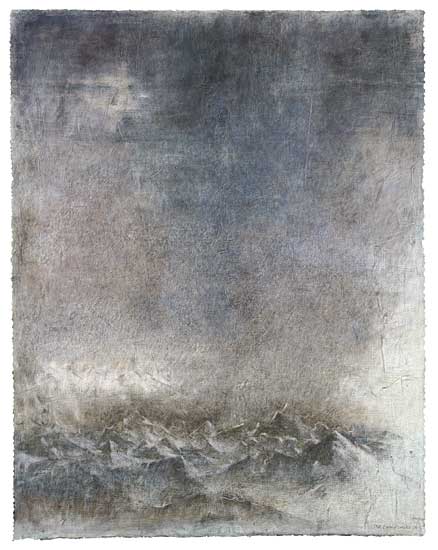Marie-Anne Poniatowska
Poniatowska lives and works in Geneva, Paris and Venice, and from those cities she often sets out for remote places which have always provided her with inspiration. Her constant comings and goings conditioned the choice of the support for her work, which is all on paper, a material that can easily be moved from one geographical point to another. Her drawings are of figurative themes which dissolve on the borderline of poetic abstraction. Her technique is arduous and laborious, and with it she imprints a personal, intimate quality upon her work, in which a restrained emotion is revealed by means of an almost sculptural treatment of matter. In 1947 she began training as an artist at the University of California, Santa Barbara, continuing her training two years later at Scripps College in Claremont, where the Painting Department was directed from 1936 to 1955 by Millard Sheets, the leader of the Regionalists in Southern California, who was always connected with mural painting and the Social Realism movement. That was her first contact with fresco painting, which since then has always been present in her work like a kind of hidden substratum. Later, contact with David Alfaro Siqueiros, whom she met during a visit to Mexico City in 1950, and with Robert Lesbounit, whose classes she attended in Paris from 1952 to 1965, introduced her to the complex world of the technique of mural painting. It is important to realize that, whatever sources she drew on, Poniatowska’s relationship with mural painting was intense during the early years of her career and had an indirect impact on the course that she followed subsequently. Certain elements of mural painting were adopted, absorbed and reshaped by the artist’s aesthetics, and there are parallels between the two techniques, drawing and fresco painting, in the methods they use for execution and preparation. The large scale of her drawings and the preparation of grounds based on layers and strata are two clear examples of this faint contact. The artist recognizes two crucial periods in her work. In the first period the small format was predominant, and she took her subjects from her immediate surroundings, concentrating emphatically on the human figure. During those years she used a soft pencil, which enabled her to make linear marks, while subtle gradations of tones made their first shy appearance. In the second period, which began in 1981, she consolidated her technique, carefully preparing the grounds of her drawings and broadening her themes, which can be classified in terms of two basic areas, portraiture and landscape. Poniatowska’s portraits express a totally new truth, fashioned by the firmness of her way of seeing. They capture the frugality of a conversation or the disconcerted expression of the person portrayed, taken by surprise. Her drawings seem accidental and unplanned, breaking away from any kind of conventionalism and entering upon a silent debate with the spectator. Denis Diderot had already laid stress on the capture of the appearance of spontaneity in everything living, a spontaneity that Poniatowska transfers to her portraits in an attempt to produce monumental work by setting out from material provided by everyday life. Pompeii and its frescos, Greece and its classical architecture and Petra and its excavated temples are some examples of the mark left on her work by the various places that she has visited in her wanderings. The images in Poniatowska’s landscapes are a portrait of her existence; we find in them, as Baudelaire said, “the object and the subject, the world outside the artist and the artist himself”. In those ruins, columns and rocky, nocturnal landscapes Poniatowska converts her gaze into the lens of a camera with which she is able to bring the reality before us closer or move it further away as easily as the effort that it costs us to adapt our vision. From those very personal viewpoints, the artist works on each fragment of the support in minute detail. In each fraction of it there is a marvellous interplay of light and shade, emptiness and saturation, which merge together, reducing their individual importance in comparison with the complexity of the whole. One might say that from the abstraction of detail, achieved by means of the delicate treatment of the grids into which she divides her work, she takes off towards the figuration of the whole. A technical aspect which is noticeable in the second period, and which defines her current style, has to do with the grounds of her pictures, prepared on the basis of layers or planes of colour applied in a certain order: a first layer of ochre acrylic paint which she stains with several coatings of almost transparent liquid preparations in blue, grey or green; she then works on those layers with pencil, charcoal or ink, subsequently covering some areas of the drawing with matter and abrading and reducing others with an eraser in order to attenuate the lines. Her forms and figures emerge from the ground, always hazy, as if captured on paper at the moment of their material disintegration. As a result, the drawing arises from within the work in its simplicity and chromatic bareness, creating an infinite subtlety in which the classical mesh mingles with a completely hazy background.



